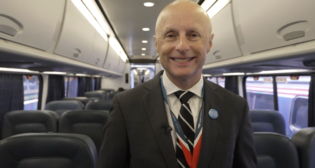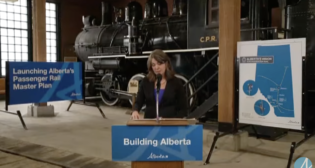
VIA Rail Adventures: Two Routes in Quebec
Written by David Peter Alan, Contributing Editor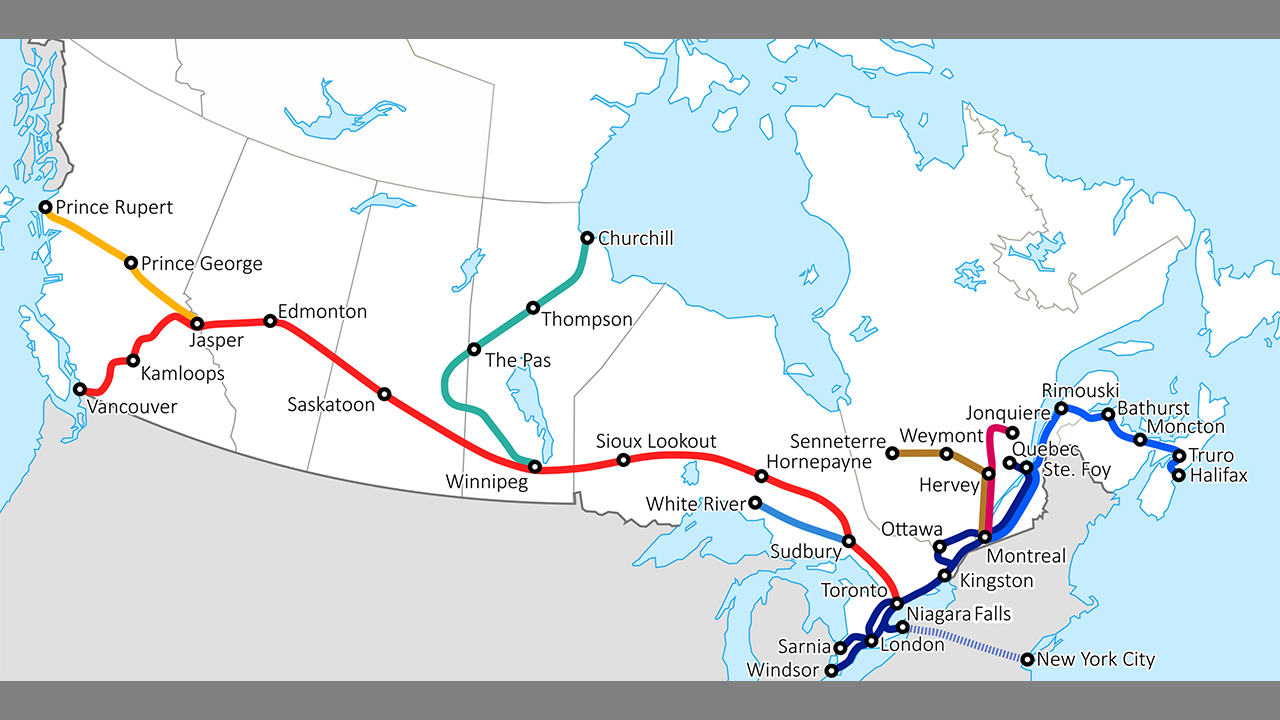
VIA Rail system map. Geography accuracy is not absolute. Line coloration is to match the colors used in the VIA Rail Timetable (February 2019). This map was remade to replace the previously included map on the VIA Rail Canada Wikipedia page that still showed the Victoria-Courtenay train in British Columbia and the Gaspe train in Quebec, which have not operated for over five years at this time. Dotted lines mark VIA Rail Canada routes operated in partnership with Amtrak. Colin Stepney/Wikimewdia Commons
Fifth in a Series: In the first four articles in this series, as well as in a separate article that focused on rail transit and tourist railroads in Canada, I described my adventures on rails during a 16-day journey to that country in August 2023. I had ridden VIA Rail trains from Toronto to Winnipeg and then to Churchill, Manitoba and the isolated “Budd Train” between Sudbury and White River, Ontario. I also reported on transit in Montreal, Toronto, Ottawa and Kitchener-Waterloo, Ontario, as well as a tourist railroad in that area.
After nine days at home, it was time to return to our Neighbor to the North for an additional ten days with more rides on VIA Rail, a tourist railroad based in Quebec City, more time in Montreal, and a visit to Halifax, Nova Scotia. That itinerary included the trains between Montreal and northern Quebec, to the towns of Senneterre and Jonquiere, the only routes in the VIA Rail system that I had not yet ridden. My trip included a visit to historic Quebec City.
On Aug. 28, I departed the Port Authority Bus Terminal in New York City for Montreal on New York Trailways. There was no train available since Amtrak’s Adirondack had been canceled for the summer. I spent Tuesday in Montreal, riding trains on the Metro, eyeballing the neighborhoods and enjoying more local foods. St. Lawrence Boulevard was great, as usual, and included smoked meat at the legendary Schwartz’s. Some of the locals still refer to the “Boulevard” as “Main Street,” and it has a strong multi-cultural flavor. Some of the people I encountered had ties to New Jersey or New York City, and almost everybody I met was comfortable speaking English and had no problem continuing Montreal’s bilingual tradition, which an increasingly Anglophobic Provincial government in Quebec City tries ever-harder to suppress.
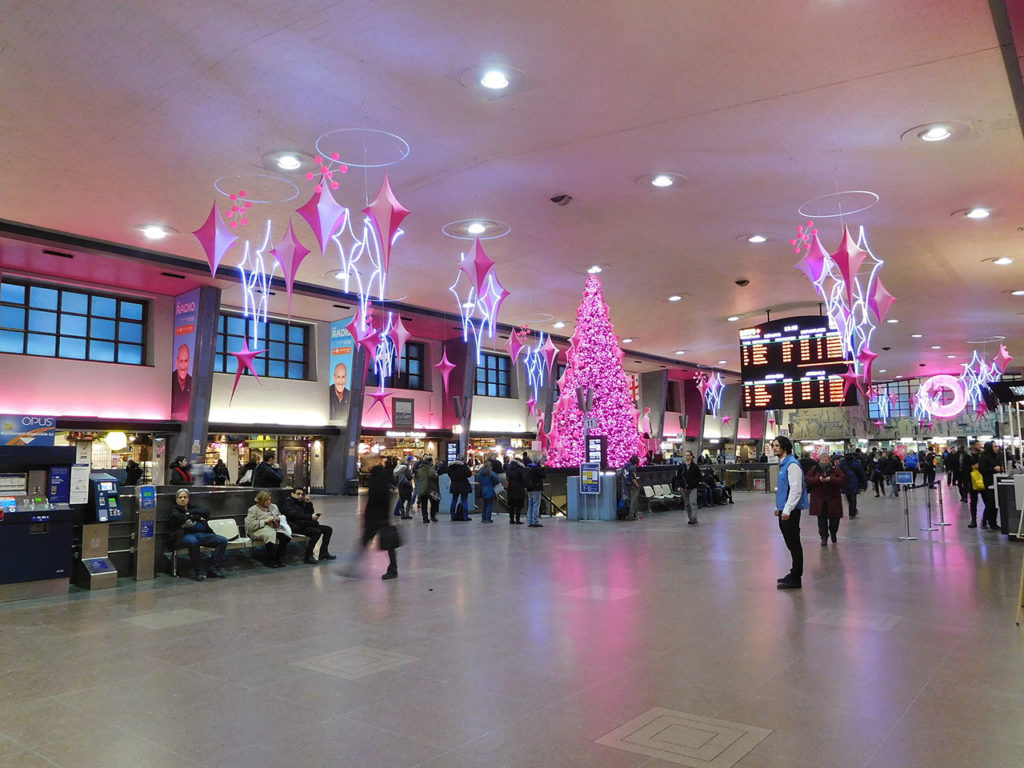
My rail adventure began the next day at Central Station, after being soaked by the early-morning rain. The weather and I dried out, and it turned out to be a good day for my ride to Senneterre on Train 603. Senneterre is a small town in northwestern Quebec, about 13½ hours from Montreal, according to the schedule (which, on VIA Rail, is only available on line, and is somewhat difficult to access). I had been apprehensive about the trip because I would be visiting two different places in northern Quebec. Essentially everybody speaks French, hardly anybody speaks English, and I do not speak any French.
At the station, the train was among the most unusual I have ever seen. It was, quite literally, two trains in one. The head half was the consist bound for Senneterre as Train 603. The hind half split at Hervey Junction and went to Jonquiere as Train 601. The train left at 7:30 and ran with its two sections combined for slightly more than four hours. Each “half” of the combined train consisted of an F40PH-2 locomotive, a baggage car that appeared to use the shell of a 1954-vintage Budd-built car from the original consist for CP Rail’s Canadian, and a single coach from that equipment roster. That coach was the only passenger-carrying car in each consist, the same sort of long-distance coach used on the trains to Vancouver and Churchill, as well as on part of the consist of the Ocean between Montreal and Halifax, which I would ride the following week. The coaches on each section were modified to add a place to store coffee, other drinks and a few snacks, items that were available for sale during the trip. The two trains run north from Montreal on Mondays, Wednesdays and Fridays. They return on Tuesdays and Thursdays, starting with an early-morning departure. On Sundays, they leave five hours later on a trip that ends with a late-evening arrival at Montreal.
Our Service Manager performed the duties typically done by the conductor on a passenger train, but VIA Rail eliminated the “conductor” jobs early in its existence. Her name was France Mehay. She had 17 years on the railroad, and she apparently ruled the extra board. She made all her announcements in French, with separate announcements in English delivered specifically to me, in a conversational tone. She typified the bilingual tradition that has long been typical of Montrealers, reading a novel in English in her spare time while interacting with her passengers entirely in French, except for me.
Like most of VIA Rail, the trains in Quebec run entirely on CN track. On its website, www.viarail.ca, the railroad describes both trips this way: “On board the train, take advantage of the large windows to marvel at the beauty of the Quebec landscapes in comfort, no matter the season. You will find yourself surrounded by nature, often far from the road, winding along rivers and around lakes.”
This promotional description is correct about the windows on the old equipment, and fairly accurate about the scenery, which is like that on many of VIA Rail’s routes. These routes were not particularly scenic, but like much of Canada east of the Manitoba prairies, they featured lots of woods and a number of lakes and rivers. They also go through several towns, some of which contain interesting old stations. Most of the stops are flag stops at remote settlements or hunting and fishing lodges, established at least a century ago to cater to wealthy “sportsmen” from the United States or elsewhere in Canada. Although the Senneterre train (and the Jonquiere train like it) carry only a single coach, it always had enough seats to accommodate every rider. According to the crews, it never gets crowded.
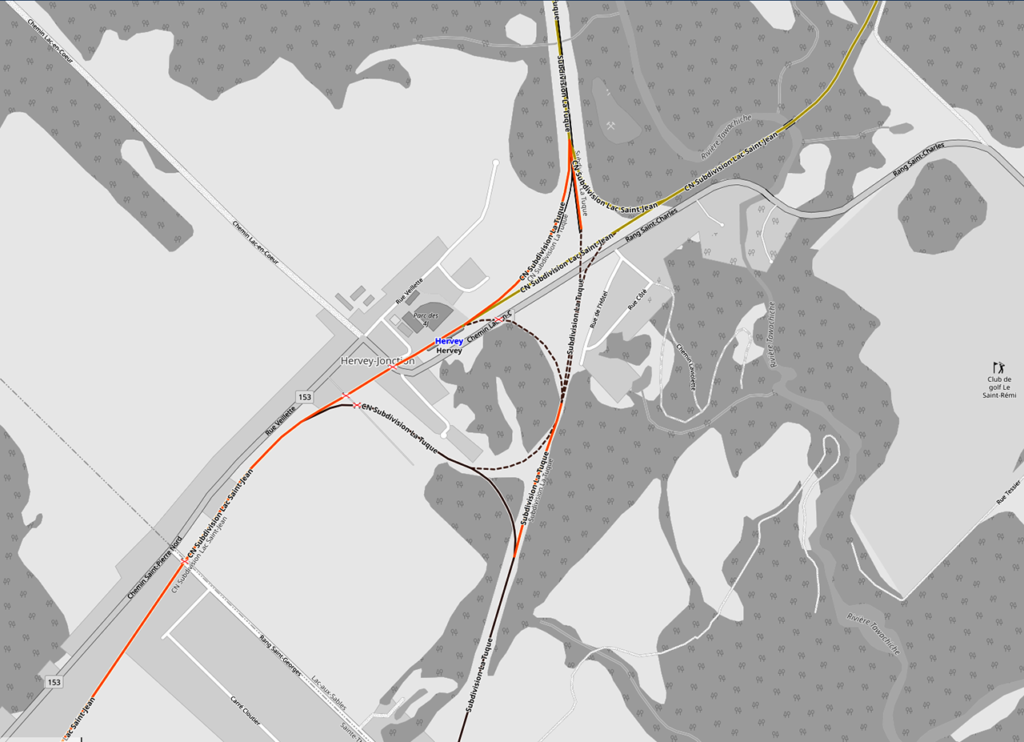
Operationally, the most interesting place on the route is Hervey Junction, where the consist splits into two trains going north and combine going back toward Montreal. The junction is not near the town of Hervey, and although there is some standing time while the crew members split or combine the trains, there is nowhere to go for a bite to eat. That opportunity occurred at the La Tuque, the next stop. The schedule called for about 15 minutes of standing time, enough to run into the food store across the street and buy a couple of locally made subs. There was nothing special about them, but they were a welcome addition to the trip. There would be no more food available that day, since the eateries in Senneterre close before the train arrives.
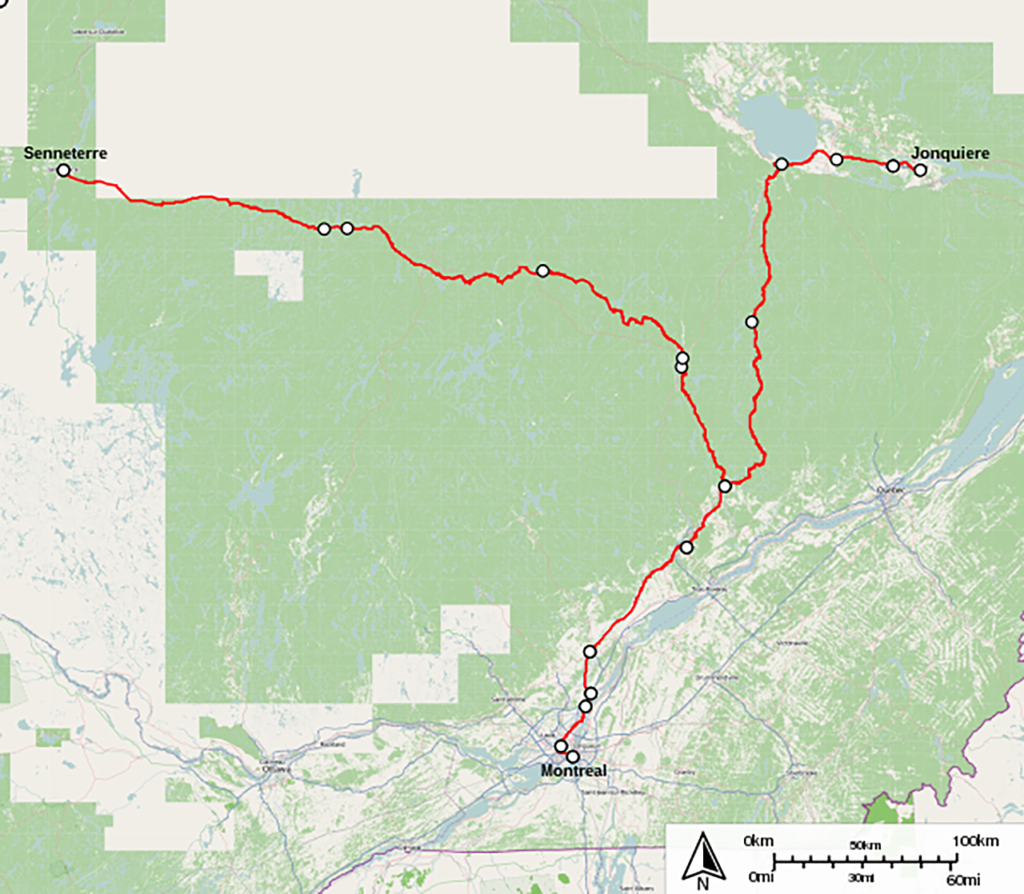
VIA Rail had once called the train the Abitibi in timetables, after the region in northwestern Quebec where the route ends. The name lives on in people’s memories but is now used only unofficially.
Senneterre is on the historic Canadian Northern Railroad, and at one time passenger trains reached there from Montreal and Quebec City. There was also a train west of there to Cochrane, Ontario, which connected with the Ontario Northland Railway. Today, the town feels like the “end of the line” with little activity. Fortunately, I was staying at the same motel as the crew members, so I walked there from the station with France, our service manager, who introduced me to the owner in French and translated my room number for me.
I got up at 5:00 the next morning and was ready to leave when I heard a knock on my door at 5:50. It was our early-rising service manager, ready to walk to the station. I had a few minutes to look over a bit of the town in the struggling pre-dawn light as the crew prepared the train for its 6:28 departure. After seeing a bit of the town, I wondered how the Friday crews felt about having to stay there until they go back to Montreal, an event scheduled for late Sunday morning. During the worst of the COVID-19 service cuts, both trains ran only once a week: on the same Friday-Sunday schedule.
The Thursday trip back to Montreal was very similar to the Wednesday trip to Senneterre, although the subs I bought at the food store in Le Tuque that day tasted better than the ones I had gotten the day before. It was also interesting to watch the crews from both trains combine them at Hervey Junction. It was a long ride back to Montreal, and our train arrived after dark and slightly behind schedule. There was time to have a sandwich and cheesecake at Dunn’s, a downtown restaurant that dates to 1927, retains much of its historic appearance and stays open all night. Then it was time for bed, in anticipation of another early morning departure the next day.
Friday, Sept. 1 was the day for the trip to Jonquiere on Train 601, the train that was once called the Sagunay in timetables, after the region in northern Quebec, but that name only lives on in memory and is only used unofficially. After the Abitibi section turns to the west after leaving Hervey Junction, the Sagunay section continues north for most of the trip and then east at Chambord. The entire trip is scheduled to take 10 hours, 20 minutes, and arrive at Jonquiere at 5:50. There was nowhere to grab a bite to eat on the way, but Jonquiere is a bigger town than Senneterre, and there would be food at the end of the line.
The experience was like those of the two previous days. Our service manager operated almost entirely in French, but spoke with me in English, one-on-one. The train was her regular assignment. It stopped at remote hunting and fishing camps like the Senneterre train, and there were more lakes along the Sagunay route than along the Abitibi route. They included Lac Sainte-Jean (Lake St. John), a large lake about one hour west of Jonquiere. I also felt a bit of extra excitement during that part of the trip because I was about to complete my segment on the last VIA Rail route that I had not yet ridden, thereby completing the system. The train station is part of a “transportation center” that also included the terminal for local buses, and we arrived at 6:15, about 25 minutes behind schedule.
My hotel was within walking distance of the station, and I had time to eat and take a walk around the town before it got dark. It was a more-interesting place than Senneterre, and I found a restaurant that served a local specialty: Tortière, is a meat pie, usually with a pork filling, that is popular with French-speaking Quebecers. Tortière du Lac Saint-Jean is a local variation consisting of cubed meat and potatoes. What I had in Jonquiere had no crust and looked like hash, served with coleslaw following a bowl of Quebec-style bean soup. It provided a fitting conclusion to that part of my Quebec adventure.
The next train would not return to Montreal until Sunday morning, but I was bound for Quebec City, instead. To get there, I walked to the bus station and took the 9:00 bus on Intercar, a Quebec-based regional carrier. The bus arrived at Quebec City about noon, andI spent the rest of the weekend there.
UNESCO has named Quebec City a World Heritage Site, and it deserves the honor. It is one of the most beautiful cities in North America, and almost every building in the downtown area is historic. The city was founded by French explorer Samuel de Champlain in 1608, and it was originally surrounded by a wall for protection.
The city is bigger now, and the wall is still standing and surrounding historic Old Quebec. Many of the residential buildings and some of the commercial buildings within the walls exhibit traditional French-style architecture. Other commercial buildings trace their origins to the Victorian Era and exhibit British influence in their design. One of the oldest houses in town is now the location of Aux Anciens Canadienes, a restaurant that serves traditional Quebec foods like tortière with a pie crust, meatball ragout with vegetables, creton (a pork paté served with toast and topped with shredded and sweetened cooked carrots), and a dessert pie with a filling made with maple syrup. Nearly every building within the walls was historic in some way, and most of the ones I saw were beautiful.
The city was alive with activity on the sunny summer Saturday (during Labor Day Weekend), and the shops and eateries along the colorful commercial streets were packed with tourists and locals alike. While almost everybody there speaks French and uses that language in everyday life, many residents also speak enough English to accommodate Anglophone visitors. There are other attractions along with and near the historic downtown area, including the Chateau Frontenac Hotel (built by Canadian Pacific and opened in 1893), and Dufferin Terrace, a broad walkway overlooking the St. Lawrence River.
Montmorency Falls is another well-known attraction, along with a nearby park of the same name. The station for the Train de Charlevoix, which I rode on Sunday, Sept. 3, features a head-on view of the falls. It is a seasonal tourist railroad that runs with a two-section German DMU train from the early 1980s and goes to La Malbaie, on the north shore of the river. I reported on that trip in greater detail, along with other tourist railroads, and Canadian rail transit (but not VIA Rail) in Canadian Railway Adventure, posted here on Nov. 13, 2023.
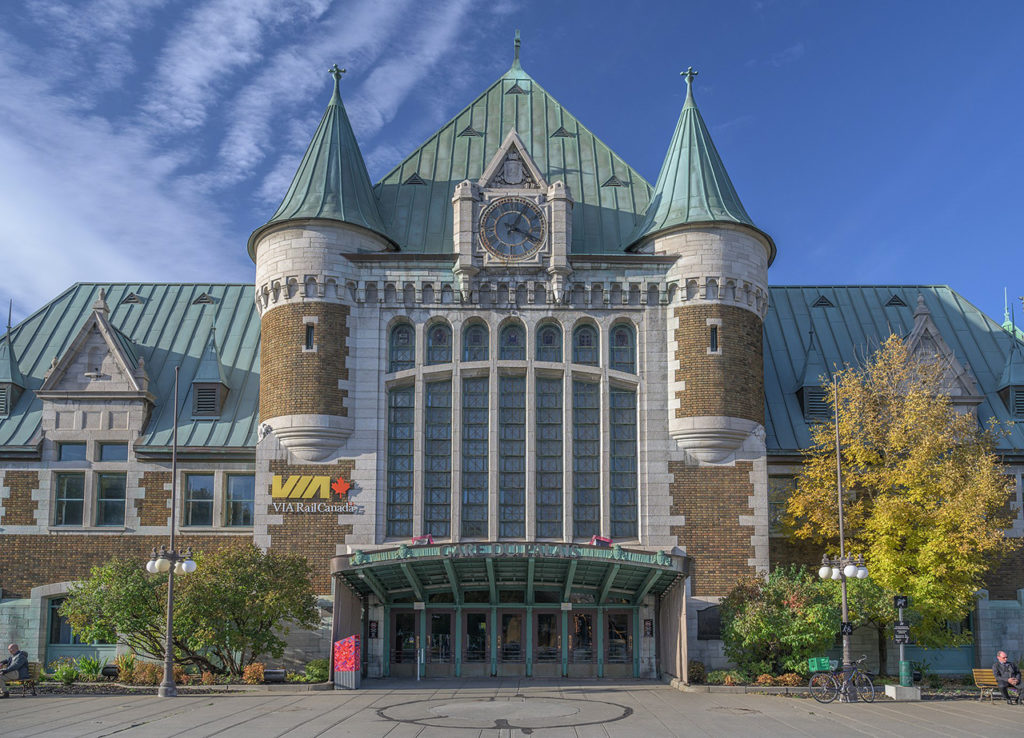
Gare du Palais (Palace Station), built by CP and opened in 1915, again serves VIA Rail trains to and from Montreal, after an absence of service that lasted from 1976 until 1985. The station’s chateauesque facade (in a similar style to the Chateau Frontenac) remains unaltered, although the tracks no longer approach the station head-on. Today, the station’s two stub-end tracks and the passenger waiting room are located to the side of the building concourse. The interior and the rail operation have lost some of their former grandeur, but a few trains still run between downtown Quebec City and Montreal every day.
Gare du Palais also serves passengers going to northeastern Quebec, New Brunswick or Nova Scotia on the tri-weekly Ocean. You connect with the train by VIA Rail shuttle vans that require an additional fare. The vans go to Sainte-Foy station, where the trains that originate in Quebec City make their next stop on the way to Montreal. It took about 35 minutes to get there from Palais Station. CN built Sainte-Foy in 1976 to replace the downtown station, and now trains to or from Montreal stop at both. The Ocean does not, though. It runs east from Drummondville to Sainte-Foy, and stops next at Montagny, east of Quebec City. I caught the Ocean on Sunday evening and arrived in Halifax on Monday evening, about three hours behind schedule.
I will conclude this series with an account of my round-trip ride on that train and my visit to Halifax, where I spent Monday night, all day Tuesday and Wednesday morning before going back to Montreal.

David Peter Alan is one of America’s most experienced transit users and advocates, having ridden every rail transit line in the U.S., and most Canadian systems. He has also ridden the entire Amtrak and VIA Rail network. His advocacy on the national scene focuses on the Rail Users’ Network (RUN), where he has been a Board member since 2005. Locally in New Jersey, he served as Chair of the Lackawanna Coalition for 21 years, and remains a member. He is also Chair of NJ Transit’s Senior Citizens and Disabled Residents Transportation Advisory Committee (SCDRTAC). When not writing or traveling, he practices law in the fields of Intellectual Property (Patents, Trademarks and Copyright) and business law. Opinions expressed here are his own.
